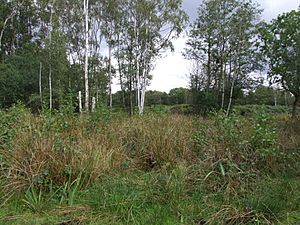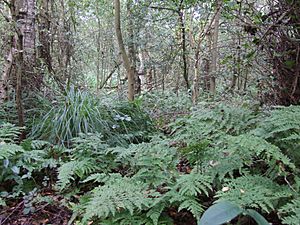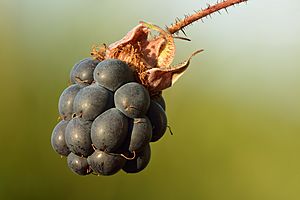Askham Bog facts for kids
| Site of Special Scientific Interest | |
 |
|
| Area of Search | North Yorkshire |
|---|---|
| Area | 110.7 acres (44.8 ha) |
| Notification | 1961 |
| Location map | Natural England |
Askham Bog is a special place in North Yorkshire, England. It's a small area of peat bog and a Site of Special Scientific Interest, which means it's protected because of its amazing nature. You can find it southwest of York, near the villages of Askham Richard and Askham Bryan. Many people think it's one of the most diverse natural spots in Northern England!
A few years ago, there was a plan to build 500 houses close to the bog. But thanks to lots of people, including famous naturalist Sir David Attenborough, this plan was stopped in 2020. This helped protect Askham Bog for all its plants and animals.
Contents
How Askham Bog Was Formed
Askham Bog started forming about 15,000 years ago. This was after the last Ice Age, when huge glaciers melted. The meltwater filled a hollow area in the Vale of York. Two natural ridges, called moraines, formed on either side. These ridges helped hold the water in place, creating the bog.
The very bottom layer of the bog is made of clay, sand, and gravel. On top of this, there are many layers of old plant material. These layers tell us about the different periods of time the bog has been through. First, there was lake clay and a special mud called nekron mud. This mud was full of nutrients from the surrounding land. It shows that the climate became warmer after the Ice Age. Many plants like Potamogeton, holly-leaved naiad, and bogbean grew here then.
Later, a plant called common reed started to grow. Its old roots show that it slowly filled in the open water. This led to a layer of fen peat forming in the middle of the bog. This peat layer grew taller, slowly turning the fen into a raised bog. As the middle of the bog got higher, it became cut off from the nutrient-rich water from the surrounding land. Rainwater then washed away the nutrients in the peat, making the soil more acidic. This change meant that the original rich fen plants couldn't grow there anymore.
Because the soil became poor in nutrients and acidic, sphagnum mosses began to grow really well. These mosses added a lot to the peat, making the raised bog even taller. This made the center of the bog completely dependent on rainwater for its nutrients. However, the edges of the bog still get water from the surrounding land. This means the edges are still rich in nutrients, similar to the famous East Anglian Fens.
Amazing Plants and Habitats
Askham Bog is known for having many different kinds of plants, insects, and birds. This is because it has a wide variety of habitats. You can find fen-meadows with rich soil on the edges. Further in, there are carr woodlands and raised bogs with acidic soil. There are also dykes (small canals) and areas of open water. This mix of habitats means many different species can live here. The bog shows how different types of land can change over time, especially from the edges to the center.
Long ago, people cut peat from the bog. This activity actually helped bring back some of the fen conditions. It allowed base-rich groundwater to reach areas that had become acidic.
Askham Bog has many trees. Birch and willow trees grow everywhere. Alder and grey sallow are common on the fenny edges. In the acidic center, oak trees are dominant. Other trees like hazel, alder buckthorn, and rowan also grow with the oak trees. Recently, birch trees have decreased, while oak, alder, and ash have grown more. When trees were cut down in the north-central part, it seemed to harm the sphagnum mosses. This might be because there was less shade, making the mosses dry out more easily. Also, more harmful substances from the air have been found in the bog. These substances come from factories that release smoke.
Herbaceous Plants of Askham Bog
The plants at Askham Bog are not only diverse but also similar to plants found in southern England. Some special plants you might see include greater spearwort, marsh stitchwort, saw sedge, marsh fern, great water dock, meadow thistle, purple small reed, and water violet. Askham Bog is also home to the largest group in England of the rare gingerbread sedge, Carex elongata. It's also famous for its beautiful royal fern.
The plants at Askham Bog can be divided into two main groups, based on whether the soil is basic or acidic. One group is a fen community with many different species, found around the edges. These include meadowsweet, common meadow rue, stinging nettle, marsh bedstraw, dewberry, bittersweet, skullcap, yellow loosestrife, creeping Jenny, and rough meadow grass.
The other group is an acid community with fewer species, found towards the center. These plants include Sphagnum palustre, purple moor grass, Rubus fruticosus, and honeysuckle. Even though sphagnum moss usually causes the soil to become acidic, it hasn't been found in some areas of the acid center where honeysuckle and Rubus fruticosus grow. This might be because there's a lot of a substance called phosphate there.
Birds of Askham Bog
More than 90 types of birds have been seen at Askham Bog! Birds visit in both winter and summer. Even though there are people nearby, the bog offers a safe place for birds in the mostly open farmland around it. In winter, there's plenty of fruit and seeds for them to eat. In summer, there are lots of insects.
Birds that live here all year include marsh tit, willow tit, treecreeper, kingfisher, goldcrest, bullfinch, tawny owl, buzzard, sparrowhawk, and sometimes green woodpecker.
In winter, you might see visitors like fieldfare, redwing, brambling, siskin, lesser redpoll, goldfinch, snipe, jack snipe, woodcock, and coot. Sometimes, a grasshopper warbler also visits. All kinds of warblers that migrate have been found at the bog in spring and summer. The reed beds in the northeast part of Near Wood are an important home for reed warblers.
Invertebrates of Askham Bog
Askham Bog is full of amazing invertebrates, which are animals without backbones like insects and spiders. It's especially known for its many kinds of water beetles, such as Haliplidae, Noteridae, Dytiscidae, and Gyrinidae. Some rare beetle species found here include Dromius sigma and Agabus undulatus. A very rare beetle called Pselaphus dresdensis has been found in moss near the ponds here, and nowhere else in England! However, the number and variety of beetles at Askham Bog have been going down since the early 1900s. This happened around the same time a waste disposal area was set up nearby. Other interesting insects you might see are the fen square-spot moth and the emperor dragonfly.
The bog also has a surprising number of spiders that like wet places, even though the reserve is getting drier. This might mean the spider community still reflects a time when the bog was much wetter. A very rare spider called Cornicularia kochi has been found in large numbers in piles of cut reeds during winter.
Mammals and Amphibians of Askham Bog
You can find typical amphibians like the common frog, common toad, and smooth newt at Askham Bog. Common mammals include roe deer and red foxes. The water vole used to be common here, but sadly, most have been taken over by the American mink.
How Askham Bog Has Been Used and Is Now Managed
Peat Cutting History
For a very long time, from the early Roman period until the mid-1700s, people used Askham Bog to cut peat for fuel. The oldest proof of peat cutting nearby comes from a Roman well in York, where lumps of sphagnum peat were found.
In the Middle Ages, villagers from Dringhouses and Acomb especially cut peat. There are old rules from the Manor of Drighouses and Acomb Court Rolls that limited how much peat tenants could cut. The strict punishments for breaking these rules show how much peat was being taken from the bog. In fact, all this peat cutting probably changed the bog's shape a lot. When the acidic peat layer was removed, the center of the bog could be flooded by nutrient-rich groundwater again, turning it back into an open fen. You can still see evidence of this in the dykes (small canals) around the main peat areas today. These dykes were likely dug to help move the peat by boat.
After people stopped cutting peat around the 1750s, the whole bog grew back into a forest. From the late 1800s until World War II, it was used as a place for hunting game. This might explain why many trees were cut down in Far Wood during that time. In 1946, Sir Francis Terry and Joseph Rowntree bought the bog. They then gave it to the Yorkshire Naturalists' Trust, which is now called the Yorkshire Wildlife Trust. It's the oldest nature reserve managed by the Yorkshire Wildlife Trust.
Hemp Growing in the Past
There's evidence that a plant called hemp was once grown at Askham Bog. Scientists found old hemp seeds and pollen preserved in layers of peat. These seeds and pollen were found with other water plants, suggesting that the hemp was soaked in water. This process is called retting, and it was done to separate the fibers from the hemp plant.
We don't know the exact dates, but hemp was probably grown a lot at Askham during the Tudor period. At that time, the King ordered people in England to grow and ret hemp to make ropes for the British navy. An old record from 1594, the Acomb Court Roll, shows rules about where hemp could be retted. This was because the process made a bad smell and could pollute rivers. However, hemp retting stopped in the 1800s. This was because England started importing hemp ropes from Europe and Russia, and later began using other fibers like sisal from America and jute from India.
Protecting the Habitat Today
The main reason the Yorkshire Wildlife Trust was created was to protect Askham Bog. Their first plan was to keep all the different habitats in the bog healthy. With help from the National Conservation Corps, they created more open water by digging ponds and blocking dykes. They also cleared away some bushes in the damp, grassy areas. In 1998, the Yorkshire Wildlife Trust received a big grant from the Heritage Lottery Fund. A lot of this money was used to manage Askham Bog. This helped make sure the water quality and levels were right for all the bog's wildlife.
Most of the areas with many different plant species are now grazed by Exmoor ponies. These ponies help new plants like marsh orchid and meadow thistle grow. They also stop strong grasses, reeds, and young trees from taking over. This is thought to be a better way to manage the land than just cutting the plants. However, some meadows on the site are still cut for hay.



